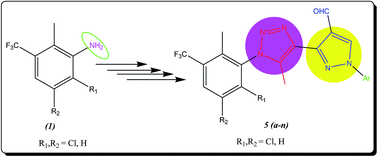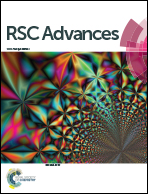Design, synthesis and characterization of new 1,2,3-triazolyl pyrazole derivatives as potential antimicrobial agents via a Vilsmeier–Haack reaction approach†
Abstract
The synthesis of a new series of 3-{5-methyl-1-[2-methyl-3-(trifluoromethyl) phenyl/substituted phenyl]-1H-1,2,3-triazol-4-yl}-1-(aryl)-1H-pyrazole-4-carbaldehyde compounds (5a–n) was carried out via a Vilsmeier–Haack formylation of 4-{(1E)-1-[2-(aryl) hydrazinylidene]ethyl}-5-methyl-1-[2-methyl-3-(trifluoromethyl)phenyl/substituted phenyl]-1H-1,2,3-triazole (4a–n) with a phosphorous oxychloride and DMF mixture. The newly synthesized compounds were characterized using IR, 1H NMR, 13C NMR, mass spectral data and elemental analysis. The newly synthesized compounds were screened for their in vitro anti-bacterial, anti-fungal and anti-oxidant activities. Some of the synthesized compounds displayed a broad spectrum of antimicrobial activities and moderate to good anti-oxidant activities. The anti-bacterial results were further supported by in silico molecular docking studies of these compounds for the inhibition of E. coli MurB enzyme (PDB code: 2MBR) and showed a minimum binding energy and good affinity towards the active pocket comparable with the standard drug Ciproflaxin. Thus, they may be considered as good inhibitors of the E. coli MurB enzyme (PDB code: 2MBR).


 Please wait while we load your content...
Please wait while we load your content...